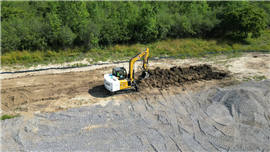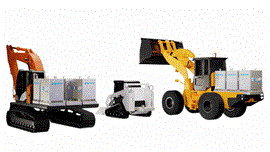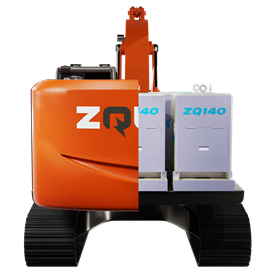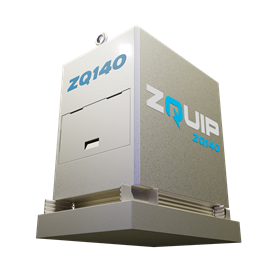Read this article in French German Italian Portuguese Spanish
Is this an effective way to convert diesel to electric? New tech’s developer thinks so.
23 February 2024

Contractors have a new way to meet zero emissions requirements on their jobsites, following the launch of a modular energy solution that converts diesel-powered construction equipment into electric machines.
The ZQuip conversion kit works on many types of machines, from large excavators to telehandlers, its developer Moog Construction has claimed.
Moog Construction has previously worked with OEMs to develop cutting-edge construction equipment, including Bobcat’s autonomous Rogue concept.
Its new ZQuip technology was introduced prior to France’s Intermat 2024 trade show (24-27 April), at a press preview earlier this year.
ZQuip first demonstrated this concept with a CAT 308, creating a ZQuip battery-electric version of the classic diesel-powered 8-ton excavator, making it one of the most powerful, energy-efficient and zero-emissions 8-ton excavators available today, the company said.
Talking to Construction Briefing’s sister publication Rental Briefing, ZQuip managing director Chris LaFleur explained that the company set out by asking how it would tackle electrification differently if it was setting out from scratch.
“In construction, it all comes down to how much something costs and how much you can get done with it. We realised what’s currently out there is not addressing those two points together,” he said.

How it works
Pointing out that not every charger or piece of software works with every machine, LaFleur claimed that modularity provides an answer.
Explaining how the company’s modular conversion kit works, he said, “We still have the same hydraulic system, but the ZQuip Battery Modules, which come in 140- and 70-kWh sizes, power the machine. It’s a zero-emissions way to spin the hydraulic pump.
“When we convert a machine, we take the tail and the counterweight off, take the diesel engine out, and then we have this blank canvas where we install the conversion kit to the platform, which can then have receptacles for however many battery modules including ballast are needed to get a job done.”
With the electric motor essentially replacing the diesel unit that was on board the machine previously, ZQuip introduces a smart controller driven by its own software to manage how the electronic side of the machine works.
Meanwhile, the battery modules are enclosed and thermally managed to keep them at a standard, optimal operating temperature.
The company’s ZE 140 and ZE 70 modules are each high voltage and run between 600 and 800 volts.
“This allows us to put them into a more compact container, with less wiring. It also gives us the opportunity to look at a size and scale of machines that others wouldn’t,” Lafleur said.
Cost

While the precise cost of a ZQuip conversion depends on the type of machine being converted, LaFleur claimed that it is cheaper than buying an equivalent new electric machine – if such a machine even exists.
“If a fleet owner has an excavator that costs $150,000, then an electric model is maybe 40% more if they can even get it. New electrical equipment doesn’t exist in a lot of cases.
“ZQuipping a fleet of machines will cost less than buying new electric models. In Europe they have mandates to do work with zero-emissions machines, but the zero-emissions machines don’t yet exist.
“When you have a diesel machine, power is unlimited, you just refuel as needed. When you have batteries, customers are forced to install and pay for the largest number of batteries (e.g., 600 kWh battery packs) they could possibly need; they’re paying for a lot of power they are not going to use. ZQuip couples the amount of energy you need with the task at hand, it makes it economically feasible,” he said.
He also claimed that the modularity of the ZQuip system would make machines more easily serviceable.
“Everything that could possibly go wrong with a ZQuipped machine is in a modular system that can be removed and replaced within a few minutes on site. Not only that, but we found that when the diesel engine is removed, it’s easier to work on the existing hydraulic system and other components,” he said.
OEM reaction

So how have OEMs reacted to the launch of ZQuip, given that they are developing their own electric versions of machines that would previously have been powered by diesel?
“They know that we’re doing this. The OEMs aren’t competing with us right now. There is nothing on the market that would compete with what we’re doing,” LaFleur said.
“The big OEMs are competing against each other, but in the meantime, the best thing we can do is try to bring something that wins over the customers and the distributors. If the customers prefer our method, and the distributors feel empowered, we can set the standard.
“There’s such an extraordinary amount of money being invested in the future of electric equipment. Without a standard and without an agreement on what this future should look like, a lot of that will be wasted.
“We just want to make it easy and operational and make financial sense to electrify jobsites. This is the way we believe the industry needs to go to succeed,” he added.
Brought To You By
|
STAY CONNECTED



Receive the information you need when you need it through our world-leading magazines, newsletters and daily briefings.
CONNECT WITH THE TEAM







